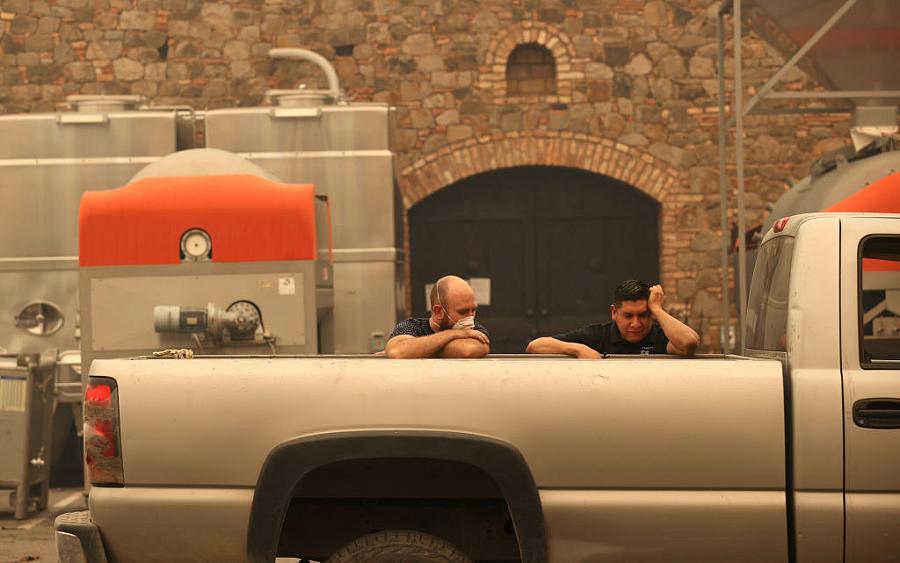In Sonoma County, a reporter tracks the long shadows of disaster

Photo by Justin Sullivan/Getty Images
Earlier this year, I set out to explore how the natural disasters that have ravaged California’s Sonoma County in recent years have widened health disparities in communities.
In some ways, I arrived in 2021 after the worst disasters had already hit — wildfires in 2017 and 2019, heatwaves and COVID-19 in 2020. But as I lived in the community, I recognized that the long shadow of trauma from the fires was everywhere.
If someone didn’t lose a house, they nearly died while trying to evacuate. If they evacuated safely, they inhaled serious amounts of smoke. If they didn’t inhale smoke, then they feared howling winds that helped turn the fires into roaring blazes. And in reporting on COVID-19, I found out how Santa Rosa Memorial Hospital’s health van brought health care to and increased trust with low-income communities across the county.
Class, climate and health
Based on my previous reporting on COVID-19, I knew that wealth was one of the strongest predictors for health outcomes. And the one thing apparent about Sonoma County is the division of wealth. The county is a prime example of how the disproportionate impact of climate change on poor communities extends beyond the global south; it is already affecting low-income communities in wealthy regions of the U.S.
In the aftermath of the wildfires, respiratory and cardiac illnesses grew worse, especially in the months after major disasters. In the case of heatwaves, the built-in inequalities in housing, notably access to air conditioning and the greater likelihood that low-income communities live in “heat islands,” had exposed residents to higher daytime and nighttime temperatures. These exacerbate the effects of heatwaves, leading to more heat stroke in these communities.
To challenge these divisions and expose health inequities, you need data. My sources’ stories about coughing up black mucus led me to seek cardiac and respiratory illness data from local hospitals after major wildfires. Anecdotes about feinting in sun-exposed fields showed me I needed to focus on not only heat-related illnesses among farmworkers but also neighborhoods where intense heat persisted. And health care providers’ details about the “eras” of the pandemic helped me better understand hospitalization data.
Overcoming challenges
Finding these stories came with challenges. Frankly, I’m a very Waspy looking guy and my Spanish is less than fluent. And the communities disproportionately impacted by disasters are often Latino and Spanish-speaking. I know that if I had been new to Sonoma County or never covered the Latino, Spanish-speaking community, I would have had struggled mightily.
Yet my relationships with bilingual volunteers at local nonprofits and Latino-serving organizations over the past two years helped me facilitate interviews and carried water for me in Spanish-speaking communities. So the best advice I can give is to honor these communities in your everyday reporting, be humble talking about experiences you’re unfamiliar with, and avoid being defensive about your ambitions for the story. And don’t grandstand as a voice for “the voiceless” — communities have their own voices.
Data gathering also came with challenges. I struggled to identify the health care codes which corresponded with the bevy of cardiac and respiratory issues. And it didn’t help that hospitals updated these codes since 2017. But I reached out to a journalist who had done reporting on similar data, and they were able to help me find the right codes (even if it required more emails back and forth than I care to admit).
When it came to COVID-19, deaths and hospitalizations surprisingly did not show significant discrepancies across race by 2023. But what this cumulative data did not show was how COVID-19 hit poor communities of color in the beginning of the pandemic, people who often worked on the frontlines, and then later hit white communities who were less inclined to get vaccinations.
It’s important to be fully present in your environment. I don’t just mean living in the area where you report. I mean strip yourself of your phone and wallet and whatever other necessities you think are important, so you can walk a block. I’ve gotten COVID covering events. I’ve had heat stroke because of a lack of shade, and slept on my porch at night because I didn’t have air conditioning. And I’ve ran up hills to cover an emerging wildfire in nothing but khakis and Reeboks. I was in the middle of a ride along when the call came in from dispatch, and I reeked of smoke and my lungs hurt the day after.
Maybe that’s a bit extreme. But I like Anthony Bourdain’s quote: “Your body is not a temple, it’s an amusement park. Enjoy the ride.” And a journalist’s body is a vessel to inform ourselves, reflect on the consequences, and survive long enough to tell stories to our audience.

